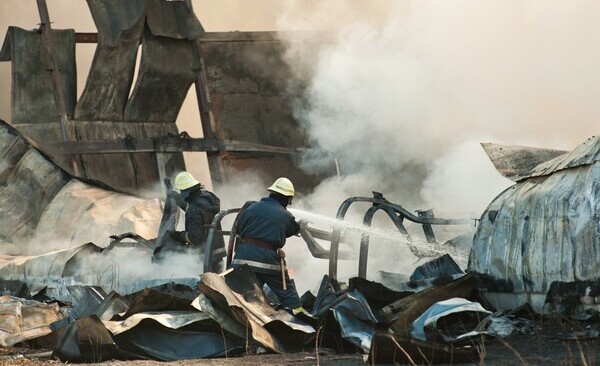
20 Mar Aviation in action
The international connectivity to the Middle East continues to support the global aviation market as the restrictions imposed by the Covid-19 pandemic lessen and is re-emerging as one of the major markets as the sector bounces back from the global turndown. As well as the Middle East, writes Peter Stephenson, Director – Fire Safety Division, Middle East, Hydrock, we see other regions and countries, such as Asia Pacific and Africa developing and maturing as business and leisure destinations with the aviation sector continuing to play an important role in getting business back to normality.
When looking at the functional requirements of the many stakeholders involved in the efficient operation of an airport and resort locations, the fire safety design presents numerous challenges for the fire engineer. Similar challenges can be found in other large mass transportation buildings, such as railway/metro stations, however, there are few building types that have complex operational support systems to enable the building function (retail, security, customs, baggage handling etc.) whilst safely ensuring a positive customer experience.
Key architectural aspirations to optimise this customer experience encourages large open spaces for the public areas and efficient operational design for back-of-house areas. To ensure an optimum design solution can be achieved that satisfies the client’s aspirations and also Civil Defense (Authority Having Jurisdiction (AHJ)), a robust fire strategy should be developed which, in many cases, will follow performance-based fire engineering techniques whilst considering compliance with local codes including GACAR requirements.
Fire Safety Objectives & Acceptance Criteria
As part of the client requirements and initial design brief, the fire safety goals and objectives for an airport/aviation project should be discussed in detail with the client and the AHJ, to ensure all requirements are captured and an agreed set of acceptance criteria is established prior to the development of the fire strategy. The considerations for seaplane and helicopter operations will need to be addressed independently as their area of operation and risk profile differs from more traditional aircraft operations.
Within an airport environment, one of the key client requirements is that the building operates and functions as smoothly as possible to ensure a positive customer experience. When considering a terminal building, this means the efficient processing of passengers with the minimum delay possible ensuring that security lines between airside and landside are maintained. This is a major challenge to be addressed within the fire strategy and requires consultation and input from all members of a design team and relevant stakeholders because once on the airside (i.e. departures) side of the terminal, a passenger or object (such as luggage) has cleared security and is deemed safe for a flight departure. This boundary between airside and landside may be formed by solid walls, partial walls/screens, doors or simply a space occupied by staff and an x-ray/security equipment. The position of this demarcation needs to be fully understood, as it needs full consideration when developing the evacuation strategy, including the provision of directional escape signage and zoning of fire safety systems.
Fire Service Access
In large terminal buildings and across the airport, the responding fire department/service typically require a single control point to receive a briefing from airport staff on their arrival at an incident to make an assessment prior to implementing their tactical response. From the access location(s), the first responders need quick and easy access to the incident floor from a protected route within a safe distance of the incident and with an adequate supply of water. The means in which they cross the airside/landside line is, therefore, an important consideration. For remote locations where seaplanes and helicopters may operate the emergency response requires careful consideration as resources and equipment may differ, for example for seaplane operations the requirement for an appropriately equipped firefighting vessel (fire boat) would need special consideration.
A Fire Command Centre (FCC) provides an operational hub within which it will be possible to receive live information from the life safety systems, including the CCTV cameras across the terminal/site. The command centre will be separated from the remainder of the terminal by fire resisting construction and should have a dedicated access route direct to open air.
The FCC should be provided with control panels for each smoke control and evacuation zone, which allows full control of an evacuation of the incident area. An evacuation can be phased on an automatic or manual basis, or the decision can be taken to simultaneously evacuate the entire terminal from the control room, if considered necessary. In addition, a microphone is provided with which direct announcements can be given to the building occupants. Communication links between the FCC and the air traffic control tower must be fully considered as remote air traffic control towers monitoring several airports are becoming a popular alternative to a site-based tower.
Business Continuity
Airports operate on a continual basis (24/7) and are a critical piece of infrastructure. Therefore, large-scale evacuations or disruption of passenger processing in a terminal could be catastrophic for the airlines and the terminal operator for commercial and reputational (brand) reasons. Business continuity goals should be established early in the design phase of a project alongside life safety and property protection objectives and the on-going design development should consider these requirements as detailed in the airport fire strategy.
The aviation sector is providing tremendous support to the realisation of regional visions and it can be seen that the complexities of fire and emergency response cannot be understated within key projects. As ever, the importance of a robust fire strategy for the effective delivery of an aviation project is a key factor during the design, construction and on-going operations to support these goals.
Hydrock is a British-owned integrated engineering design, energy and sustainability consultancy.




Sorry, the comment form is closed at this time.